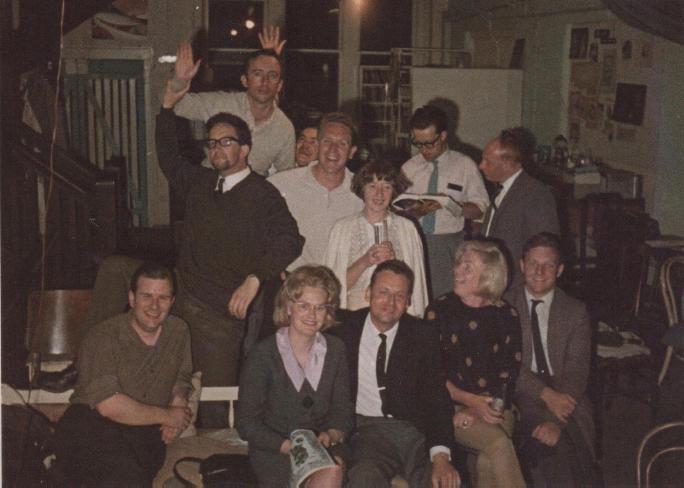Nineteen Somerset Place
John Foyster
Somerset Place is one of those dead-end lanes you find in large cities
that lead only to warehouses and illegally-parked cars. Somerset Place
is probably the lane nearest to the centre of Melbourne, so unimportant
it shows up on only the most detailed maps. During most of the 1960s it
was the hub of the activities of science fiction fandom in Melbourne.
Somerset Place runs behind McGills Bookstore (whose rear entrance is
almost at the end of the lane), and number 19 was, for many years the
McGills warehouse. It housed the Melbourne Science Fiction Club in the
1960s almost by accident.
In 1960 the Melbourne Science Fiction Club had fallen on quite lean
times. Since it had ceased publishing ETHERLINE in 1958 it had no
regular fanzine to produce. And since 1958 US science fiction magazines
and paperbacks could both be imported into Australia, so the need for
the club's library was much diminished. Its 1960 clubrooms, in McKillop
Street in Melbourne's CBD, got crowded as soon as two members sat down
to play chess. The room was hardly a viable one to rent.
And that's where Mervyn Binns's employment at McGills came in handy.
Merv had been working at McGills all through the 1950s, selling large
quantities of science fiction. And in looking around for alternative and
more useful premises Merv noticed that the third floor of the McGills
warehouse was unoccupied.
This became a matter of putting one and one together to make a happy
partnership, and so at the end of 1961 the MSFC packed up its duplicator
and its library and moved to Somerset Place. (I suspect that this
actually happened in January 1962, while I was conveniently holidaying
in Western Australia.)
The new premises were, by comparison, vast. The third floor was
approximately fifteen feet by forty feet, and as it was (almost) the top
floor the ceiling was rather more than twelve feet high.

The clubroom, including one side of the infamous water-powered lift.
The personnel in the photo are:
Front row: John Bangsund, Carla Harding, Bob Smith, Jill Dudding,
Cedric Rowley
Second row: John Foyster, Tony Sander, Margery Sander
Back row: Mervyn Barrett, John Straede (almost hidden), Mervyn Binns,
Dave Sofar
Photo by Lee Harding.
|
There were two ways of reaching the clubrooms. You could use two (long)
flights of stairs, or you could use the water-powered lift. Most people
used the latter, unless they had had some recent reason for nervousness.
You opened and closed a lattice-wooden door, yanked down on a rope in a
slot at the side of the lift, and then ascended gently to the third
floor. You could stop off at the second floor by grabbing the rope, but
there was rarely any reason to. If the lift wasn't there you could ring
a bell and hope someone would send it down.
You might become nervous about using the lift had you recently had
played on you one of the tricks of the club, invented by Don Latimer.
The component of the lift that actually moved up and down consisted of
the floor and two sides (no top, no front or back). Don decided that it
would be friendly to welcome newcomers as they ascended in the lift. To
do this, he would answer the bell by getting into the lift, starting it
on its way down, and then halfway down grab onto the outside wall where
the back of the lift wasn't. Then, as the lift came back up, he would
jump onto the lift's floor to welcome the visitor. This was a much more
effective welcome at night, when there was little or no light in the
lift.
Once you got out of the lift, you found yourself in a largish room of
the dimensions already mentioned. The lift door actually faced onto a
storage space under the stairs that ascended from clubroom level up to a
mezzanine which housed three toilets, and which also (at one time in the
late 1960s) was known as the shooting gallery and then, even later in
the 1960s, was used as a platform for two full-size 35mm short-focus
projectors, used on a very frequent basis by the Melbourne Fantasy Film
Group. So far as the author is aware, this area was used for sexual
activities only once, briefly in 1965 during a film show.
What follows is a general description of the third floor and how it was
used during the 1960s, although obviously there were different
arrangements as the club evolved.
Underneath the mezzanine, and quite near the lift, sat the AFPA
duplicator (a Roneo 750) and all the associated workings. In this area
also you would find the bookshelves housing what remained of the MSFC
library, and whatever heating and cooking equipment happened to be
available. A hollow rectangle was filled out by a desk (and some
cupboards) that marked out the area that Merv, the club librarian (the
only club office during most of the 1960s) occupied.
In front of the desk and cupboards were several low tables at which
cards or chess could be played, with a few chairs surrounding them.
Next, and we are now adjacent to the stairs running up to the mezzanine
floor, some rows of seats, covered in pale green pseudo-leather, rescued
from an old movie theatre. This made the Melbourne Fantasy Film Group,
not to mention the 1966 convention, possible. And the seat colour
matched the pale green of the painted brick walls.
Next was the main area of activity - the table-tennis table. Most nights
it was very hard to get a turn at the table.
Except near the table-tennis end there was plenty of room to congregate,
so most of the time there would be small groups of fans dotted around
the room engaged in various activities - usually not doing much at all.
Copyright © 2000 by John Foyster
